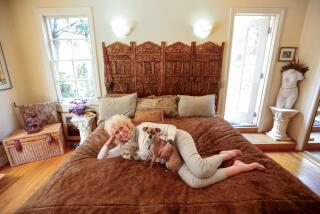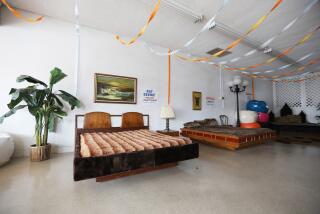Someone’s Been Lying in Hall’s Water Bed : Invention: In the early days, it hardly made sense to sue small-time dealers for patent infringement. But by 1985, 4 million units were sold annually.
SANTA ROSA — The inventor of one of the sexual revolution’s most popular accessories isn’t exactly what you’d expect.
Sure, Charlie Hall was a graduate student living in Haight-Ashbury in 1968 when he developed a water bed in a design class. But there’s not a beaded curtain, bong or crushed velvet anything in his modern ranch-style residence on 35 acres north of San Francisco.
Hall is more likely to discuss the “surface tension ratio of mattress size to containing frame” than free love.
And yes, he is a millionaire, but mostly from other inventions. With a few exceptions, Hall’s 1971 patent for a water bed has not been honored by companies that manufacture them.
Now, however, businesses might think twice about ignoring that patent.
In March, a federal court jury in San Francisco awarded Hall $4.8 million in a patent infringement case against Intex Plastics of Long Beach, which imports and sells water-bed mattresses, liners and heaters. And although Intex has asked the judge to overturn the jury’s decision, Hall’s attorneys have asked for an increase in damages.
When it comes right down to it, Hall, 47, creator of the stoners’ bed of choice is--and always has been--a square. Indeed, he has never regarded the water bed as a sex toy, but rather as a health-oriented piece of furniture.
“He’s the classic inventor if you think of the stereotype. He likes to tinker with things, more than people,” said Jim Patterson, a former business partner in Innerspace Environments Inc. Hall’s first water bed manufacturing venture, which lasted six years.
“He was not even slightly grooving with the rock ‘n’ roll and drugs going down at the time,” recalled J. Baldwin, who taught the San Francisco State University graduate design class in which Hall designed his water bed. “The other students didn’t quite know what to think of him. He was Mr. Straight, but he was doing one of the grooviest things to come down.”
Said Hall, “(Initially) I thought, ‘We’ll all be sleeping on these in a year.’ But what an ordeal it was.”
The ordeal began in the winter semester of 1967-68 with 300 pounds of rotting goo. Hall set out to design as a master’s thesis the world’s most comfortable chair. What he got was “the incredible creeping chair,” which was filled with a gelatin and cornstarch mixture. When the cornstarch started to decompose and emit noxious gas, he barely could move the chair to his back porch.
Trial, error and interviews with medical doctors led him to try water instead of goo. When Hall introduced the prototype water bed--an 8-foot-square water-filled plastic mattress--”he knew he had a winner,” Baldwin said.
He put his invention, named the “Pleasure Pit,” in the “Happy Happenings” show at the San Francisco Cannery art gallery in the summer of 1968. It was written up in newspapers and magazines across the country.
But Hall had finished graduate school and moved to Southern California later that summer to teach art in a prep school. It took several months before the hoopla caught up with him and he was called back to the Bay Area.
He applied for a patent in 1969 and in the same year, with a friend, started Innerspace Environments Inc. to manufacture water beds, delivering them to individuals in a Rambler station wagon. He sold them to members of the Jefferson Airplane and Tommy Smothers, and Hugh Hefner ordered one to put next to his Roman bath in the Chicago Playboy mansion.
“I advised him to go to New York and find the nastiest New York lawyer he could find, and he didn’t,” Baldwin said. “So he had some problems. . . . He lost control of the water bed. Pretty soon, everyone and his mother were making water beds.”
Cheap imitations were turning up in head shops. (Although other designers had received patents for water-filled beds, most of those were awarded for hospital equipment; Hall’s invention sparked the home market.)
“It was the splinter faction that hurt the business,” Hall said, noting that bargain-basement bags of water were responsible for the horror stories: Water beds bursting, falling through floors, burying people alive.
Meanwhile, at Innerspace, which had grown to 32 stores in California, company executives tried to market the water bed as an upscale, healthy piece of furniture ranging from $300 to $500.
It didn’t work.
“We were selling a fairly expensive product when the real volume was in the head shops and counterculture,” Hall said. “It was very much youth oriented, but we weren’t selling at youth prices.”
Innerspace went under in 1975.
Hall went off on his own to form Basic Designs, a company he still owns and runs out of his hillside home overlooking Matanzas Creek Winery. It was with Basic Designs that he finally made his fortune, creating camping equipment designed to bring the comforts of home--such as solar-heated portable showers and inflatable kitchen sinks--to the outdoors.
In the early days, Hall said, it wouldn’t have made much sense to sue fly-by-night water-bed dealers for patent infringement. But by 1985, with about 4 million beds sold annually, Hall decided to try to regain some of what he had lost. He negotiated out-of-court settlements with some manufacturers (for about $400,000) and was preparing to file a complaint with the International Trade Commission to try to stop Intex from importing water beds from Taiwan.
Based on that pending complaint, Intex sued Hall to deny his patent. “There are at least 10 or 12 patents for a bag of water in a frame,” said Francis Utecht, an attorney for Intex. “The earliest patent goes back a hundred years.”
Hall made a counterclaim for patent infringement damages, but when he realized how much it would take to fight Intex in court, he turned to longtime friend and investor Roger Dillan. Forming a partnership called WBX, Hall and Dillan syndicated the lawsuit against Intex, raising $750,000 from investors who now have claim to some of Hall’s $4.8 million settlement. (Hall will ultimately get about one-third of the final settlement.)
Hall seems very relaxed these days, now that the jury has ruled in his favor, friends say. He is buying a home in Santa Barbara, as well as building himself a new shop, a new place to tinker at the Santa Rosa ranch.
But the ordeal has changed him. “He looks at a situation with a little more hardened eye,” said Patterson.
And he has taken up a new venture--the plight of inventors like himself. He plans to work with Dillan on their newly formed Patent Protection Institute and build a huge investor war chest to pursue other patent infringements.
Oh . . . and he did get an A in his design class.
More to Read
Inside the business of entertainment
The Wide Shot brings you news, analysis and insights on everything from streaming wars to production — and what it all means for the future.
You may occasionally receive promotional content from the Los Angeles Times.










